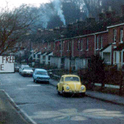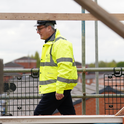Is there really a “housing crisis”? Are we really so desperately short of new homes? Inside Housing reports that developers have left more than 1.4m homes unbuilt since 2007, despite securing planning permission. But cities, towns, villages and hamlets across England have new homes under construction, not only on almost every spare piece of land within their boundaries, but on farmland and even on green belt, now rebranded as “grey”. It’s easier and cheaper to build on this than on brownfield sites in cities. This is despite the fact that reducing commuting by building more new homes in urban areas would be good for the environment and for people.
For small traditional market towns like Moreton-in-Marsh at the northern tip of the Cotswolds, which has already grown by more than 40 per cent since 2011, a glut of new housing could be the beginning of the end. With one main road through the centre of the town and the traffic now frequently at a standstill, while two big estates under construction are connected to utilities, locals and visitors are finding other places to shop, spend and live. Moreton-in-Marsh’s traders report a significant downturn in business. Some have closed and many say they are unlikely to survive. Wages here are low. Life is very unlike Jilly Cooper’s vision of the Cotswolds.
So, what does this have to do with the so-called housing crisis? It’s related due to a combination of factors. First, the decades-long impact of Margaret Thatcher’s failure to ensure that councils were required to replenish the housing stock that was depleted when they sold off thousands of council properties under-value, thanks to the Housing Act (1980). Second, the side effect of housing policy that puts infrastructure much too far down the line. We are always playing catch-up, and Moreton-in-Marsh is typical of dozens of towns and villages across England.
New government targets aimed at achieving Angela Rayner’s dream of 1.5m new homes by 2029 are impacting rural towns and villages, with the potential to alter completely the historic character of the countryside. Right across the country, from London to Lancashire, Cumbria to the Cotswolds, it seems local residents in small towns and villages are protesting new development proposals. But those in power are not listening.
The UK needs to change the basic financial concept behind the way in which it delivers new homes. The so-called housing crisis is not about all housing. It’s really only about the dire shortage of what are referred to as affordable homes. And yet, everywhere you look, we’re still building or planning vast volumes of two, three, four and five-bedroom “executive” homes. Such properties are decidedly not aimed at first-time buyers or renters. The latest of two large estates on the edge of Moreton-in-Marsh has a few one-bed properties recently discounted to just under £200,000. The majority are nearer £800,000, however, and some are £1 million.
There were about 60 empty or unsold houses here, new and old, as well as six empty shops, in May 2025. And yet, the development continues with the prospect of up to 42 per cent of the total allocation of 15,000 new homes, as per Cotswold District Council figures, for the whole of the district being shoe-horned into Moreton, where just 6.4 per cent per cent of the area’s total population lives. There are currently some 5,700 residents, so a further 6,000 or more houses would bring about 15,000 more residents and require the long overdue upgrading of the town’s infrastructure, services and amenities. A longed-for bypass is estimated to cost around £60m, but there is simply no funding for it.
The sheer volume of housing research, statistics, statements, policies and government documents are too numerous to absorb, but while they all agree that the sale of council houses started the rot, the adequacy and accuracy of these assessments is often just apocryphal. We’re told Moreton’s station will guarantee its popularity with commuters, but in reality, few use its unreliable service and its unhelpful routes. Most Moreton residents drive to work and school (there’s no secondary school in the town; around 200 children are bussed or driven daily half an hour away to two other towns).
The council talks of good employment prospects, but there is no evidence of any major new employers wanting to take a risk and come to Moreton. The bulk of work available already is confined to a small number of tea or coffee shops, pubs, hotels, charity shops, lower-cost supermarkets and a garden centre. Most positions are filled. From time to time, there are a few vacancies in hospitality.
In addition, various government policies since the 1980s have opened the way for private investors to buy up homes and offer them for rent. So with fewer lower-value homes available for first timers, prices rise, fewer buyers can afford them and that creates the demand for rental properties. And so rents rise too, creating a “win-win” for the investors and the opposite for potential buyers of a first home. There isn’t a single property to rent in Moreton today for less than £1,500 per month.
In an act of determined short-sightedness, successive governments since the 1980s have failed to require councils to build sufficient social housing. Instead, they have relied on housing associations and private developers to do the job. This has a doubly negative impact. Demand for truly affordable housing hugely outstrips supply, pushing prices and rents up. This continues to fuel house price inflation, and particularly at times when interest rates are relatively affordable, fuelling even more demand.
Few understand that developers of properties sold on the open market are required to pay a statutory levy to the council for planning permission–effectively buying the right to build. This levy is then used towards the creation of additional or upgraded infrastructure to support the residents of the new development. No such levy is payable by developers of social housing as the profit margins are so low.
Now (or should that be, yet again?) the government is trying to address the problem through massively increasing the rate of general housebuilding. In March, the government said it would “set out details of further new government investment in social and affordable housing”. In this week’s Spending Review Rachel Reeves allocated more than £39bn over the next 10 years to support an Affordable Homes Programme. It’s not all new money, but it’s still a significant increase. Whether or not Reeves’s pledge will be effective in motivating developers to build enough affordable homes remains to be seen. Whether or not it will kick-start “a generational boost in the delivery of new social homes”, as Kate Henderson, chief executive of the National Housing Federation put it, is equally uncertain.
According to an analysis of 2021 census data by Martha Dillon, there are 1.4m more dwellings in England than individuals and households to fill them. At first that seems bizarre until you take into account all the buy-to-lets, Airbnbs and, in some areas, second homes that fill the gap.
But if we continue to rely on commercial developers to build affordable homes, funded by profits on the much bigger number of private homes in a development, we will never solve the problem with the housing market. Factor in private investors buying up many of the lower-priced homes to offer for private rental and the original plan fails on every count.
For small towns like Moreton-in-Marsh the outcome of continuing on this trajectory could be catastrophic, with thousands more homes being built on land which is becoming more expensive. This in turn makes so-called affordable homes simply unaffordable for housing associations and councils to buy, let alone households struggling to get on the housing ladder.
The whole concept of relying on the developers is flawed. To make matters even worse, frequently the additional promises developers make to get their proposals through planning—footpaths, green spaces, tree planting and the rest—don’t materialise once construction is underway. And no-one holds them to account. The government’s proposed simplification of rules that require developers to safeguard wildlife habitats on the site of a proposed development (known as biodiversity net gain rules) has been widely criticised.
Until the provision of actually affordable homes takes priority over developers’ profits, the UK will never build its way out of this “crisis”. Sadly, despite the impacts of such ill-conceived policy on local areas, there is no indication yet that the solution could come from local government. Councillors, facing upheaval through impending local authority mergers, often seem more concerned with impressing central government for having delivered their target of thousands of new homes—most of which don’t address the problem they are supposed to solve—than with actually addressing the problems in the market. From our experience of observing many council meetings and seeing councillors at work, all too often there seems to be a conflict between the role of councillors as locally elected representatives (their primary role is to represent their ward or division and the people who live in it, according to the Local Government Association definition) and the pressure put on council officials to deliver what Whitehall wants.
How we deliver affordable homes today isn’t working. It never has and never will; and we are all paying the price as small towns, farmland, green belt and natural habitat are being lost for ever. Towns like Moreton-in-Marsh don’t need thousands of new homes—just a few hundred affordable ones.












